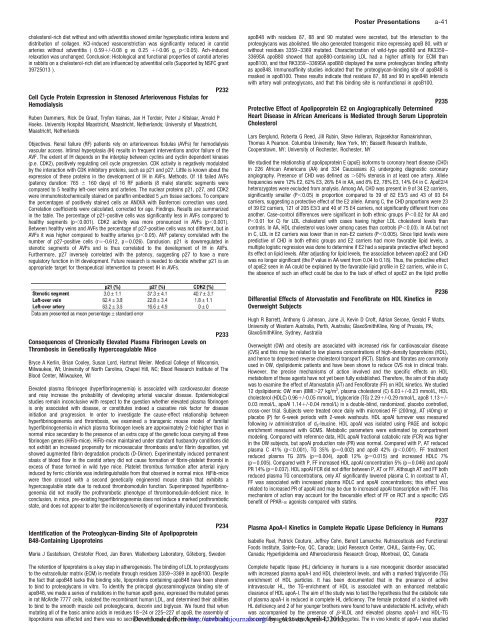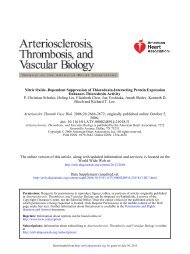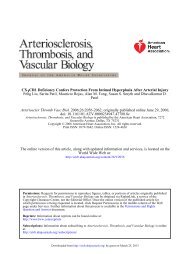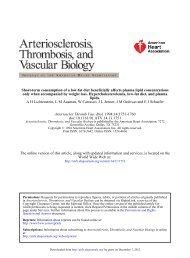Oral Presentations - Arteriosclerosis, Thrombosis, and Vascular ...
Oral Presentations - Arteriosclerosis, Thrombosis, and Vascular ...
Oral Presentations - Arteriosclerosis, Thrombosis, and Vascular ...
You also want an ePaper? Increase the reach of your titles
YUMPU automatically turns print PDFs into web optimized ePapers that Google loves.
cholesterol-rich diet without <strong>and</strong> with adventitia showed similar hyperplastic intima lesions <strong>and</strong><br />
distribution of collagen. KCl-induced vasoconstriction was significantly reduced in carotid<br />
arteries without adventitia ( 0.59/-0.08 g vs 0.25 /-0.06 g, p0.05). Ach-induced<br />
relaxation was unchanged. Conclusion: Histological <strong>and</strong> functional properties of carotid arteries<br />
in rabbits on a cholesterol-rich diet are influenced by adventitial cells (Supported by NSFC grant<br />
39725013 ).<br />
Cell Cycle Protein Expression in Stenosed Arteriovenous Fistulas for<br />
Hemodialysis<br />
Ruben Dammers, Rick De Graaf, Tryfon Vainas, Jan H Tordoir, Peter J Kitslaar, Arnold P<br />
Hoeks. University Hospital Maastricht, Maastricht, Netherl<strong>and</strong>s; University of Maastricht,<br />
Maastricht, Netherl<strong>and</strong>s<br />
P232<br />
Objectives. Renal failure (RF) patients rely on arteriovenous fistulas (AVFs) for hemodialysis<br />
vascular access. Intimal hyperplasia (IH) results in frequent interventions <strong>and</strong>/or failure of the<br />
AVF. The extent of IH depends on the interplay between cyclins <strong>and</strong> cyclin dependent kinases<br />
(p.e. CDK2), positively regulating cell cycle progression. CDK activity is negatively modulated<br />
by the interaction with CDK inhibitory proteins, such as p21 <strong>and</strong> p27. Little is known about the<br />
expression of these proteins in the development of IH in AVFs. Methods. Of 18 failed AVFs<br />
(patency duration: 765 160 days) of 16 RF patients (8 male) stenotic segments were<br />
compared to 5 healthy left-over veins <strong>and</strong> arteries. The nuclear proteins p21, p27, <strong>and</strong> CDK2<br />
were immunohistochemically stained on paraffin embedded 5 m tissue sections. To compare<br />
the percentages of positively stained cells an ANOVA with Bonferroni correction was used.<br />
Correlation coefficients were calculated, corrected for age. Findings. Results are summarized<br />
in the table. The percentage of p21-positive cells was significantly less in AVFs compared to<br />
healthy segments (p0.001). CDK2 activity was more pronounced in AVFs (p0.001).<br />
Between healthy veins <strong>and</strong> AVFs the percentage of p27-positive cells was not different, but in<br />
AVFs it was higher compared to healthy arteries (p0.05). AVF patency correlated with the<br />
number of p27-positive cells (r-0.612, p0.026). Conclusion. p21 is downregulated in<br />
stenotic segments of AVFs <strong>and</strong> is thus correlated to the development of IH in AVFs.<br />
Furthermore, p27 inversely correlated with the patency, suggesting p27 to have a more<br />
regulatory function in IH development. Future research is needed to decide whether p21 is an<br />
appropriate target for therapeutical intervention to prevent IH in AVFs.<br />
Consequences of Chronically Elevated Plasma Fibrinogen Levels on<br />
<strong>Thrombosis</strong> in Genetically Hypercoagulable Mice<br />
P233<br />
Bryce A Kerlin, Brian Cooley, Susan Lord, Hartmut Weiler. Medical College of Wisconsin,<br />
Milwaukee, WI; University of North Carolina, Chapel Hill, NC; Blood Research Institute of The<br />
Blood Center, Milwaukee, WI<br />
Elevated plasma fibrinogen (hyperfibrinogenemia) is associated with cardiovascular disease<br />
<strong>and</strong> may increase the probability of developing arterial vascular disease. Epidemiological<br />
studies remain inconclusive with respect to the question whether elevated plasma fibrinogen<br />
is only associated with disease, or constitutes indeed a causative risk factor for disease<br />
initiation <strong>and</strong> progression. In order to investigate the cause-effect relationship between<br />
hyperfibrinogenemia <strong>and</strong> thrombosis, we examined a transgenic mouse model of familial<br />
hyperfibrinogenemia in which plasma fibrinogen levels are approximately 2-fold higher than in<br />
normal mice secondary to the presence of an extra copy of the genetic locus carrying all three<br />
fibrinogen genes (HiFib-mice). HiFib-mice maintained under st<strong>and</strong>ard husb<strong>and</strong>ry conditions did<br />
not exhibit an increased propensity for microvascular thrombosis <strong>and</strong>/or fibrin deposition, yet<br />
showed augmented fibrin degradation products (D-Dimer). Experimentally induced permanent<br />
stasis of blood flow in the carotid artery did not cause formation of fibrin-platelet thrombi in<br />
excess of those formed in wild type mice. Platelet thrombus formation after arterial injury<br />
induced by ferric chloride was indistinguishable from that observed in normal mice. HiFib-mice<br />
were then crossed with a second genetically engineered mouse strain that exhibits a<br />
hypercoagulable state due to reduced thrombomodulin function. Superimposed hyperfibrinogenemia<br />
did not modify the prothrombotic phenotype of thrombomodulin-deficient mice. In<br />
conclusion, in mice, pre-existing hyperfibrinogenemia does not induce a marked prothrombotic<br />
state, <strong>and</strong> does not appear to alter the incidence/severity of experimentally induced thrombosis.<br />
Identification of the Proteoglycan-Binding Site of Apolipoprotein<br />
B48-Containing Lipoproteins<br />
Maria J Gustafsson, Christofer Flood, Jan Boren. Wallenberg Laboratory, Göteborg, Sweden<br />
P234<br />
The retention of lipoproteins is a key step in atherogenesis. The binding of LDL to proteoglycans<br />
to the extracellular matrix (ECM) is mediate through residues 3359–3369 in apoB100. Despite<br />
the fact that apoB48 lacks this binding site, lipoproteins containing apoB48 have been shown<br />
to bind to proteoglycans in vitro. To identify the principal glycosaminoglycan binding site of<br />
apoB48, we made a series of mutations in the human apoB gene, expressed the mutated genes<br />
in rat McArdle 7777 cells, isolated the recombinant human LDL, <strong>and</strong> determined their abilities<br />
to bind to the smooth muscle cell proteoglycans, decorin <strong>and</strong> biglycan. We found that when<br />
mutating all of the basic amino acids in residues 18 –24 or 225–227 of apoB, the assembly of<br />
lipoproteins was affected <strong>and</strong> there was no secretion Downloaded of human apoB. from<br />
However, recombinant<br />
http://atvb.ahajournals.org/<br />
Poster <strong>Presentations</strong> a-41<br />
apoB48 with residues 87, 88 <strong>and</strong> 90 mutated were secreted, but the interaction to the<br />
proteoglycans was abolished. We also generated transgenic mice expressing apoB 80, with or<br />
without residues 3359–3369 mutated. Characterization of wild-type apoB80 <strong>and</strong> RK3359 –<br />
3369SA apoB80 showed that apoB80-containing LDL had a higher affinity for ECM than<br />
apoB100, <strong>and</strong> that RK3359–3369SA apoB80 displayed the same proteoglycan binding affinity<br />
as apoB48. Immunoaffinity studies indicated that the proteoglycan-binding site of apoB48 is<br />
masked in apoB100. These results indicate that residues 87, 88 <strong>and</strong> 90 in apoB48 interacts<br />
with artery wall proteoglycans, <strong>and</strong> that this binding site is nonfunctional in apoB100.<br />
P235<br />
Protective Effect of Apolipoprotein E2 on Angiographically Determined<br />
Heart Disease in African Americans is Mediated through Serum Lipoprotein<br />
Cholesterol<br />
Lars Berglund, Roberta G Reed, Jill Rubin, Steve Holleran, Rajasekhar Ramakrishnan,<br />
Thomas A Pearson. Columbia University, New York, NY; Bassett Research Institute,<br />
Cooperstown, NY; University of Rochester, Rochester, NY<br />
We studied the relationship of apolipoprotein E (apoE) isoforms to coronary heart disease (CHD)<br />
in 226 African Americans (AA) <strong>and</strong> 334 Caucasians (C) undergoing diagnostic coronary<br />
angiography. Presence of CHD was defined as 50% stenosis in at least one artery. Allele<br />
frequencies were 12% E2, 62% E3, 26% E4 in AA, <strong>and</strong> 8% E2, 78% E3, 14% E4 in C. ApoE2/4<br />
heterozygotes were excluded from analysis. Among AA, CHD was present in 9 of 34 E2 carriers,<br />
significantly smaller (P0.05) in proportion compared to 39 of 82 E3/3 <strong>and</strong> 43 of 93 E4<br />
carriers, suggesting a protective effect of the E2 allele. Among C, the CHD proportions were 23<br />
of 39 E2 carriers, 121 of 205 E3/3 <strong>and</strong> 40 of 75 E4 carriers, not significantly different from one<br />
another. Case-control differences were significant in both ethnic groups (P0.02 for AA <strong>and</strong><br />
P0.01 for C) for LDL cholesterol with cases having higher LDL cholesterol levels than<br />
controls. In AA, HDL cholesterol was lower among cases than controls (P0.03). In AA but not<br />
in C, LDL in E2 carriers was lower than in non-E2 carriers (P0.005). Since lipid levels were<br />
predictive of CHD in both ethnic groups <strong>and</strong> E2 carriers had more favorable lipid levels, a<br />
multiple logistic regression was done to determine if E2 had a separate protective effect beyond<br />
its effect on lipid levels. After adjusting for lipid levels, the association between apoE2 <strong>and</strong> CHD<br />
was no longer significant (the P value in AA went from 0.04 to 0.18). Thus, the protective effect<br />
of apoE2 seen in AA could be explained by the favorable lipid profile in E2 carriers, while in C,<br />
the absence of such an effect could be due to the lack of effect of apoE2 on the lipid profile<br />
Differential Effects of Atorvastatin <strong>and</strong> Fenofibrate on HDL Kinetics in<br />
Overweight Subjects<br />
P236<br />
Hugh R Barrett, Anthony G Johnson, June Ji, Kevin D Croft, Adrian Serone, Gerald F Watts.<br />
University of Western Australia, Perth, Australia; GlaxoSmithKline, King of Prussia, PA;<br />
GlaxoSmithKline, Sydney, Australia<br />
Overweight (OW) <strong>and</strong> obesity are associated with increased risk for cardiovascular disease<br />
(CVS) <strong>and</strong> this may be related to low plasma concentrations of high-density lipoproteins (HDL),<br />
<strong>and</strong> hence to depressed reverse cholesterol transport (RCT). Statins <strong>and</strong> fibrates are commonly<br />
used in OW, dyslipidemic patients <strong>and</strong> have been shown to reduce CVS risk in clinical trials.<br />
However, the precise mechanisms of action involved <strong>and</strong> the specific effects on HDL<br />
metabolism of these agents have not yet been fully established. Therefore, the aim of this study<br />
was to examine the effect of Atorvastatin (AT) <strong>and</strong> Fenofibrate (FF) on HDL kinetics. We studied<br />
12 dyslipidemic OW men (BMI27 kg/m 2 , plasma cholesterol (C) 6.03/-0.23 mmol/L, HDL<br />
cholesterol (HDLC) 0.96/-0.05 mmol/L, triglyceride (TG) 2.29/-0.29 mmol/L, apoB 1.13/-<br />
0.03 mmol/L, apoAI 1.14/-0.04 mmol/L) in a double-blind, r<strong>and</strong>omized, placebo controlled,<br />
cross-over trial. Subjects were treated once daily with micronised FF (200mg), AT (40mg) or<br />
placebo (P) for 6-week periods with 2-week washouts. HDL apoAI turnover was measured<br />
following iv administration of d 3-leucine. HDL apoAI was isolated using PAGE <strong>and</strong> isotopic<br />
enrichment measured with GCMS. Metabolic parameters were estimated by compartment<br />
modeling. Compared with reference data, HDL apoAI fractional catabolic rate (FCR) was higher<br />
in the OW subjects, but apoAI production rate (PR) was normal. Compared with P, AT reduced<br />
plasma C 41% (p0.001), TG 35% (p0.002) <strong>and</strong> apoB 42% (p0.001). FF treatment<br />
reduced plasma TG 28% (p0.004), apoB 12% (p0.015) <strong>and</strong> increased HDLC 7%<br />
(p0.005). Compared with P, FF increased HDL apoAI concentration 5% (p0.046) <strong>and</strong> apoAI<br />
PR 14% (p0.037). HDL apoAI FCR did not differ between P, AT or FF. Although AT <strong>and</strong> FF both<br />
reduced plasma TG concentrations, only AT significantly lowered plasma C. In contrast to AT,<br />
FF was associated with increased plasma HDLC <strong>and</strong> apoAI concentrations; this effect was<br />
related to increased PR of apoAI <strong>and</strong> may be due to increased apoAI transcription with FF. This<br />
mechanism of action may account for the favourable effect of FF on RCT <strong>and</strong> a specific CVS<br />
benefit of PPAR- agonists compared with statins.<br />
P237<br />
Plasma ApoA-I Kinetics in Complete Hepatic Lipase Deficiency in Humans<br />
Isabelle Ruel, Patrick Couture, Jeffrey Cohn, Benoit Lamarche. Nutraceuticals <strong>and</strong> Functional<br />
Foods Institute, Sainte-Foy, QC, Canada; Lipid Research Center, CHUL, Sainte-Foy, QC,<br />
Canada; Hyperlipidemia <strong>and</strong> Atherosclerosis Research Group, Montreal, QC, Canada<br />
Complete hepatic lipase (HL) deficiency in humans is a rare monogenic disorder associated<br />
with increased plasma apoA-I <strong>and</strong> HDL cholesterol levels, <strong>and</strong> with a marked triglyceride (TG)<br />
enrichment of HDL particles. It has been documented that in the presence of active<br />
intravascular HL, the TG-enrichment of HDL is associated with an enhanced metabolic<br />
clearance of HDL apoA-I. The aim of the study was to test the hypothesis that the catabolic rate<br />
of plasma apoA-I is reduced in complete HL deficiency. The female prob<strong>and</strong> of a kindred with<br />
HL deficiency <strong>and</strong> 2 of her younger brothers were found to have undetectable HL activity, which<br />
was accompanied by the presence of -VLDL <strong>and</strong> elevated plasma apoA-I <strong>and</strong> HDL-TG<br />
concentrations. by guest All 3 subjects on April were4, E32013 homozygotes. The in vivo kinetic of apoA-I was studied














